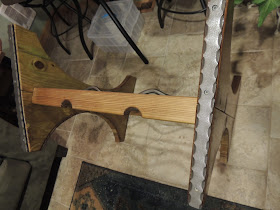It starts with creating the stand on which the barrel will sit. Pressure treated 2x10's are dried for about a half of a year. A premade template is used to draw the pattern on the wood. A bandsaw cuts the 4 pieces that will be used as the legs.
Here is a shot of the legs cut out and ready for assembly.
After the legs are glued and screwed together a template is used to route the recessed openings for the crossbraces.
Holes for the metalwork are measured and drilled. Then the entire leg assembly is routed using a roundover bit.
The inside of the assembly is dual action sanded then hand sanded.
The crossbraces are then cut to size using a 5 degree angle on each side so once assembled, the legs tilt in at the top. Note the half circle markings on the piece. his is where the wine bottle necks will sit.
The drill press is used to cut the half circles into the piece.
Rough stock of prefabricated ironwork is selected and prepared for cutting. Special care on where to cut makes a difference in the end product of where things line up.
A etal chop saw makes the cuts.
All of the cut edges are ground down.
Each piece of metalwork is acid washed and painted.
The inside of the leg assembly is stained as this is a tough area to get to after the stand is assembled.
The crossbraces ans metalwork is placed in position.
The opposing leg assembly is attached and the unit is screwed together in predrilled countersunk holes.. Wooden pegs are glued in covering the screws and sanded flush.
A decorative wooden design iscreated by cutting strips of wood then gluing and bradnailing them to the upper leg assembly. This covers any screws that were used putting the leg assembly together.
Additional metawork is measured and cut to length. Holes are drilled through the piece for attachment to the stand.
Larger holes are drilled halfway through the piece. This will allow the attachmnet screw to be countersunk. The decorative metalwork is then painted.
3 inch screws attach this metalwork to the stand.
Nailheads are ground down, painted, and added to the existing metalwork to complete the rustic look.
Now it's time for the barrel.
A barrel is selected that is'nt too rough. All but the outer steel rings are removed.
The entire barrel is sanded with 80 grit on a dual action sander. Then the barrel is refined to 180 grit.
The door for the cooler is marked and a hinge is temporarily added to determine loction. Stainless steel screws are added in appropraiet locations to hold the barrel together.
The two inner bands are cut where the door will go.
It's time to cut the opening. This is the most nerve racking part. One slip and the barrel is ruined.
Fiberglass resin is added to the mat and allowed to cure.
The lid is coated with a 2 part epoxy based rubberized coating. This is similar to what they use fro truck bedliners. It has very good insulating properties.
The complete inside of the barrel is coated.
After the coating has dried, it's time to coat the barrel with a medium oak stain.
Once the stain has dried for at least a day, either a polymerized exterior tung oil or an exterior urethane finish is applied.
When the finish has dried, the lid, hinge, and handle can be attached. The hinge and handle have been given a rustic touch and refinished.
Detail work is appied to each barrel head. One side gets a grape cluster and the other gets a hook that can be used to hold a towel. The towel is perfect for drying you hands after reaching in to grab a cold one.
The stand and cooler on display at an event. A custom 220 quart cooler and wine rack!
































No comments:
Post a Comment